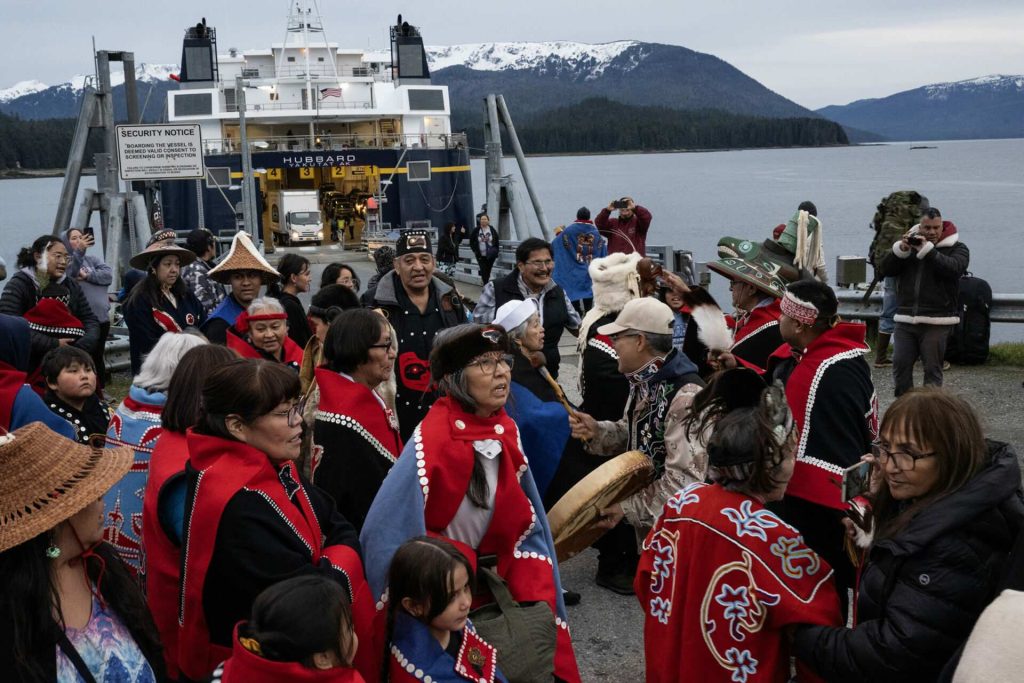On a cold and cloudy Friday afternoon, Tlingit clan leaders stood ready to welcome guests to Angoon.
For millennia, the Tlingit have lived on Admiralty Island, or Xootsnoowú, the fortress of the bears. Adorned in regalia, clan leaders performed a traditional Tlingit welcoming ceremony to their ancestral lands.
“We welcome you with open arms,” said Daniel Johnson, Jr., a leader of the Deisheetaan clan.
Facing the Tlingit was Rear Adm. Mark Sucato, commander of the Navy Region Northwest, along with a handful of uniformed Navy personnel.
Daniel Johnson Jr. greets Rear Admiral Mark Sucato, commander of Navy Region Northwest, after Sucato disembarked a ferry in Angoon, Alaska, on Friday, Oct. 25, 2024. (Marc Lester/Anchorage Daily News/TNS)
“We have come for your ku.éex’!” Sucato said.
Generations of Tlingit had fought for this moment to start burying their sorrow. Now, the momentous day was upon them.
The United States Navy was finally going to apologize for what it did on Oct. 26, 1882.
The Angoon Bombardment
Tlingit oral tradition says the attack was a surprise. Shells rained down on the village. Marines landed and set fire to homes. At least six children died of smoke inhalation.
Storehouses filled with food for the winter were destroyed, and priceless clan mementos were stolen from ruined homes. All but one of the village’s precious dugout canoes, or yaakw, were destroyed.
Angoon had been obliterated.
Jamiann S’eiltin Hasselquist and Darlene McKinley listen as a Navy representative offers an official apology for the 1882 bombardment of Angoon, Alaska, on Saturday, Oct. 26, 2024. “So much relief,” McKinley said of her reaction to the apology. (Marc Lester/Anchorage Daily News/TNS)
Decades later, Billy Jones, who was 13 at the time of the attack, told the story of the destruction of his village to an anthropologist.
“They left us homeless on the beach,” he said.
At the time, Alaska was under the jurisdiction of the U.S. Navy. The top naval official in Alaska was Cmdr. E. C. Merriman.
Three days before the bombardment, a harpoon gun on board a whaling ship exploded, killing Téel ‘ Tlein, a Tlingit medicine man and healer from Angoon, who was working as a crew member.
According to Tlingit oral history, villagers mourned Téel ‘ Tlein, and painted their faces with coal tar and tallow to mourn, which was interpreted by the whaling station’s employees as a sign of a looming attack.
Naval records said the Tlingit took two white employees as hostages and threatened to kill them, justifying the bombardment.
Dancers enter the community event at the Angoon school on Saturday, Oct. 26, 2024. U.S. Navy officials issued a formal apology to Angoon during a ceremony on Oct. 26 for a bombardment in 1882 that killed children and destroyed the village, food storehouses and dugout canoes. (Marc Lester/Anchorage Daily News/TNS)
In a letter sent days later to the secretary of the Navy, Merriman said that after the attack he spoke to village elders, who told him “they would never attempt anything of the kind again.” The lesson had been learned, he said.
“They were glad that I had burned the village,” he said.
The Tlingit of Angoon have consistently denied any hostages were taken. Historians noted the attack was ostensibly to free hostages, but their fate was not recorded by Merriman and others.
Without shelter or supplies, it remains unknown how many people died in the first winter from starvation and exposure. According to Tlingit oral tradition, it took five years for the villagers to recover and to start rebuilding.
“The people of Angoon nearly starved to death, all of them. How much we suffered,” Jones said.
The ku.éex’
The descendants of those who survived the bombardment gathered on Saturday for a long-awaited ku.éex’, or potlatch.
The most significant ku.éex’ in Tlingit culture are memorials that help mark the end of a mourning period. Clan treasures are displayed. Precious regalia is worn.
Rear Admiral Mark Sucato, near center, listens to the acceptance of the apology offered by the Navy in Angoon, Alaska, on Saturday, Oct. 26, 2024. (Marc Lester/Anchorage Daily News/TNS)
For decades, the Tlingit of Angoon and their supporters have asked the Navy to apologize for destroying their village. For decades their efforts were rebuffed — until now.
“As we all know, this is a monumental event that we’re here to witness,” said Alan Zuboff, a Tlingit elder. “Our grandfathers wished this would (have come) in their time. They are all here with us in spirit. Right this very moment.”
Angoon, or Aangóon, usually has just over 350 people. The village’s population swelled Saturday, with the high school’s gymnasium packed with people. Some had traveled a long way to be there.
Marilyn Boggs, a nurse who lives in Arizona, said her ancestors left Angoon after it was destroyed and settled in Hoonah. She returned to witness the apology.
“It’s been a long time coming,” she said.
Angoon, located on Admiralty Island in Southeast Alaska, on Sunday, Oct. 27, 2024. (Marc Lester/Anchorage Daily News/TNS)
The people of Angoon were told in May the apology would soon happen. The ku.éex’ took months of planning with the Navy to ensure it was handled with care. And now the day was here.
On the 142nd anniversary of the bombardment, Rear Adm. Mark Sucato stood before Angoon and formally apologized.
“(The Navy) acknowledges that the Tlingit people of Angoon did not deserve nor provoke the bombardment and subsequent destruction of their village by the U.S. Naval forces,” he said.
Sucato said the Navy “expresses its regret for the long delay” in issuing a formal apology. Quoting Secretary of the Navy Carlos Del Toro, Sucato said, that “it’s never too late to do the right thing.”
The gymnasium erupted in thunderous and prolonged applause when Sucato was finished. The crowd shouted their thanks in Tlingit — “Gunalchéesh!”
One by one, Tlingit leaders accepted the Navy’s apology, dressed in regalia that embodied their ancestors.
Shgen George, housemaster of the Killer Whale Tooth House, gave a detailed and emotional account of the devastation wrought on Angoon. After the apology, she thanked the Navy.
“But now is the time we will put our sorrow aside. We will wipe our tears. This is our grandfathers — these hats that we wear — they’re right here and they’re the ones who are saying, ‘thank you,’” she said.
U.S. Sens. Lisa Murkowski and Dan Sullivan were here for the ku.éex’. Both senators had campaigned for the apology and highlighted that the people of Angoon had never given up on their fight.
The Tlingit of Angoon had streaked their faces with black paint to show they were in mourning. Until Saturday’s ceremony, the sorrow could not end. People here said it was as if Angoon had been destroyed yesterday.
With the apology, the mourning could stop. A new stage of reconciliation could begin. The black paint was wiped away. The memorial turned to a celebration that continued long into the night.
The evening saw endless plates of food and the traditional exchanging of gifts between hosts and guests.
‘We are still here’
Shortly after 1:30 a.m., with the gym still full, it was time for the outgoing song. Members of the Navy’s band danced in uniform with the people of Angoon.
More than 15 hours after it began, the ku.éex’ was over. But the destruction of Angoon 142 years ago won’t be forgotten.
Rosita Worl, president of Sealaska Heritage Institute, had long campaigned for Saturday’s apology. She said it was now part of Tlingit history that would be taught for generations to come.
“It is now your responsibility to ensure our culture survives,” she said to the gym full of elders and young people.
Throughout the day, sitting in pride of place in the gymnasium — next to a framed copy of the Navy’s apology — was an ornately carved beaver figurine under a Tlingit vest and Navy hat.
The carved beaver adorned the one canoe that survived the Navy’s bombardment. Oral history says the canoe allowed the Tlingit to gather food over the first winter to survive.
When the canoe was no longer usable, it was cremated in a ceremony like a person. The beaver prow was lost in the early 20th century. But it was randomly rediscovered in New York in 1998, and repatriated to Angoon.
The beaver prow had somehow survived, and so had the Tlingit of Angoon.
“We are still here,” said Garfield George, house master of Deishú Hít. “We are still here, standing on our grandfathers’ land.”
___
© 2024 Anchorage Daily News
Distributed by Tribune Content Agency, LLC.







